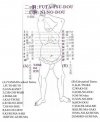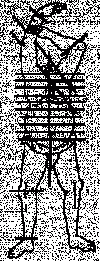I have owned many Japanese body test blades over the years. At one time that was all I collected, but then my focused changed and I sold most of them.
You may have read or heard of too many romanticized accounts of swords retaining some mystical properties, an aura or whatever. They are just swords and all of them were made for killing. I haver never felt anything any different in them than any other sword. People who recount those types of experiences obviously have vivid imaginations. If my wife or girlfriend told me she couldn't stay in the same room or house with something like that I would on have one word for her, "bye".
Swords with inscribed "Body Tests" or Tameshigiri tests were for the most part used to test the swords cutting ability, not just for killing. In fact, while they were used on convicted criminals scheduled for execution, most were tested on cadavers. There were many different cuts (see chart attached) and sometimes multiple bodies would be stacked up and cuts performed to see how many they would cut through. Dead bodies move a whole lot less when you are trying to cut them

At least with Japanese swords, with so many used in battle, the numbers of them used for killing far out number the "Body test" blades. Some retain nicks and gouges from sword strikes in battle known as "Kirikomi" and are fairly common. Though they are not proof of killing.
With body test blades there were two families of government sponsored testers, the Yamada and Yamano families. Each family of testers carried on their work through several generations. They kept detailed records of swords sharpness and sword smiths who produced the best cutting swords. They were rated as follows: Saijo O-wazamono - (best cutting swords), O-wazamono - (excellent cutting swords), Ryo-wazamono - (very good cutting swords), Wazamono - (good cutting swords).
Other types of tests were performed as well, such as Kabuto or helmet tests. This is were they would cut into a wart helmet or kabuto to see if the blade would withstand such a blow.
Tameshigiri is still performed today only on Tatami mats and such, no cadavers (note my avatar).
Here is a link to a set of books on the subject with some drawings you may like.
http://yakiba.com/Book_BodyTests.htm
Here are links to a couple of swords, one a helmet test, one a body test, and one a super rare blade named "Head splitter" and as the name would indicate it split a human head.
http://yakiba.com/katana_munetsugu.htm
http://yakiba.com/kat_kaneshige.htm
http://yakiba.com/kat_atama_pg2.htm







